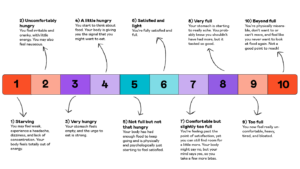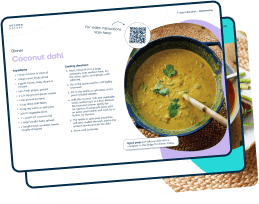Jump to: What is mindful eating? | How to eat mindfully | Eating without distraction | Take your time | Eat until you’re comfortably full | Take home message
Mindfulness refers to paying attention to something, on purpose, without judgement, and experiencing the present moment.
Mindfulness meditation is the most common example of this practice, where you learn to pay attention to your breath and allow your thoughts to come and go without allowing them to dictate your feelings.
Medication-assisted weight loss with a future focus
Start with Wegovy or Mounjaro, transition to habit-based health with our support


What is mindful eating?
Mindful eating, therefore, is the practice of paying attention to the food you’re eating on purpose without judgement.
People struggle with the ‘without judgement’ element of mindful eating. Too often, we run away with thoughts of guilt or shame based on our food choices.
We’re too quick to identify foods as either ‘good’ or ‘bad’, and the practice of eating becomes a neverending battle; this often leads to overeating the foods we identified as bad.
You may have seen mindful eating trending on social media. Fortunately, it’s not just a fad.
Research has suggested that mindful eating can aid weight loss for people living with obesity, curb carb and sugar cravings, and support healthy eating habits.
It seems to train you to tune into your internal hunger signals (satiety), build a positive relationship with food to support your mental health, and savour your meals to feel satisfied.
Alongside psychological and medical support, there’s also some evidence it can be an effective tool in treating eating disorders.
Mindful eating can start with three simple steps:
- Eat without distraction: Enjoy your eating experience. eat at a table at mealtimes, and switch off your television, laptop, or smartphone.
- Take your time: Chew your food thoroughly, tune into the physical sensations you experience, and sip water between bites.
- Eat until you’re comfortably full: Use the Second Nature hunger scale at the base of this article.
At Second Nature, our nutritionists and dietitians can provide 1-2-1 support to help you learn to eat more mindfully and build a positive relationship with food.
Previous members, like Lorraine, have developed a positive mindset around eating after being on the Second Nature programme and learning to eat mindfully.
Take our health quiz here if you’d like to give Second Nature a go.
How to eat mindfully
We’ve identified three simple, evidence-based mindful eating practices that can help you learn to eat mindfully, lose weight, build a more positive relationship with food, and, most importantly, learn to love food again.
1) Eat without distraction
Removing distractions should be the first step when looking to eat more mindfully. Research has shown that we disconnect ourselves from our hunger cues when distracted, increasing how many calories we eat in each meal.
A study placed 20 participants into two groups that completed two different interventions. The first group was given a pizza and allowed to watch a television show. In a second session, they consumed pizza while listening to a symphony. The second group completed the same protocol but was given macaroni cheese.
The study showed that watching television increased caloric intake by 36% in the pizza group and 71% in the macaroni cheese group. Suggesting that being distracted and watching television can lead to increased intake during meals and possibly weight gain in the long term.
Here’s how to do it:
- If possible, eat at a table or desk and turn off all devices that might distract you from your meal.
- Place your smartphones or tablets in the other room and focus on your meal.
- Pay attention to the smells and tastes of the food as you eat.
2) Take your time
It’s estimated that many fullness signals sent to the brain can take around 20 minutes to register after you’ve started eating. Therefore, it’s suggested that by eating slower and allowing our body’s fullness hormones to register in the brain, we can reduce the amount of food we eat in a meal.
A meta-analysis (a study that reviews many studies on one topic) of 22 studies looking into eating rates and energy intake found that slower eating rates were associated with lower food consumption.
Similarly, a trial comparing slow and fast eating rates in premenopausal women showed that women in the quick eating group consumed 67 more calories of the same meal compared to the slower eating group.
This suggests that taking your time and eating your meals more slowly, compared to mindless eating, could lead to reduced energy intake and positively affect weight in the long term.
This may also help you enjoy your food more; paying more attention allows you to enjoy the tastes, aromas, and textures more intensely.
Here’s how to do it:
- Try the 20-20 technique: chew each mouthful for 20 seconds, and aim to take 20 minutes to eat your whole meal.
- Pay attention to the smells and tastes of the food as you eat.
- Enjoy a glass of water with your meal and sip between mouthfuls.
3) Eat until you’re comfortably full
Our bodies are designed to let us know when we’ve eaten enough. Our stomach and gut send signals, using fullness hormones, to our brain to tell it that we’ve had enough to eat, and the brain responds by increasing our feelings of fullness.
The trouble is that many people have a disconnect between our physical and psychological hunger cues. Research has shown how our stress and emotions can influence when and how much food we eat.
Fortunately, we’ve developed some guidance on identifying and tackling emotional eating here. Alongside this, using the Second Nature hunger scale to determine your levels of physical hunger can be a great way of learning how to tune into your feelings of hunger and fullness.
Here’s how to do it:
- See the Second Nature hunger scale below.
- Ideally, we’d start eating between levels 1-4 and stop eating between levels 5-7. When you’ve reached levels 8-10, you know you’ve had too much and can adapt for next time.
- Feel free to download this image and keep it on your fridge or somewhere visible at home.
Take home message
Weight gain can be driven by distraction, eating too quickly, and the disconnect between our hunger and fullness signals.
By developing a mindful-eating mindset, you’ll create a more positive relationship with food and feel full and satisfied with your nourishing meals without overdoing it.
Eating mindfully is possibly not something that will come naturally to you; it will take practice and patience as you learn a new skill. Fortunately, the techniques used to develop mindful eating is accessible, free, and can be implemented immediately.
By practising these techniques every day, mindful eating will likely start to become second nature, you’ll be able to savour healthy foods, and your health will thank you for it.



